Types of Commercial Flat Roofs – 14 Strong Roofing Options

When it comes to commercial roofing, flat roofs have become a popular and practical option for many businesses. Unlike traditional pitched roofs, flat roofs provide a sleek, modern look while offering unique benefits, especially for commercial buildings. These roofs are ideal for maximizing available space, providing a solid foundation for rooftop HVAC systems, and allowing for easy installation of solar panels.
What are the characteristics of flat roofs?
Flat roofs are characterized by their minimal slope—typically a pitch of 10 degrees or less—allowing for a nearly level surface. This feature makes them a cost-effective and efficient choice for commercial properties. With a variety of materials and systems available, flat roofs can be customized to meet the needs of different environments, budgets, and structural requirements.
In this article, we’ll explore 14 different types of commercial flat roofs, their features, and the materials that make them suitable for various commercial applications. Read on to discover the best options for your business and find the right fit for your building.
1. EPDM Roofing
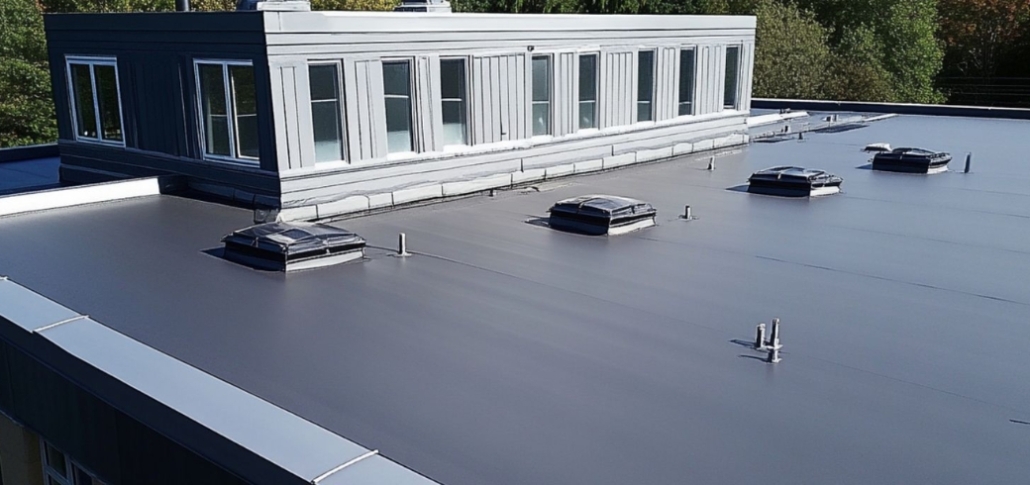
EPDM (Ethylene Propylene Diene Monomer) is one of the most popular types of commercial flat roofing materials due to its durability, cost-effectiveness, and ease of installation. This synthetic rubber roofing membrane is commonly used in both new construction and roof replacements, offering a long-lasting solution for flat roof systems.
EPDM is available in both black and white options, with the black variety being more popular due to its ability to absorb heat, which can be beneficial in colder climates. The white version, on the other hand, reflects sunlight, making it a good choice for areas with warmer climates as it helps to keep buildings cooler and reduce energy costs.
Key Benefits of EPDM Roofing
| Benefit | Description |
| Durability | EPDM is highly resistant to weather conditions, including extreme temperatures, UV rays, and ozone exposure, making it an excellent choice for commercial buildings. |
| Low Maintenance | The roofing material is easy to maintain, requiring only periodic inspections and simple repairs if necessary. |
| Long Lifespan | With proper care, EPDM roofs can last up to 50 years, offering long-term value for building owners. |
| Energy Efficiency | The reflective properties of white EPDM roofing can help reduce cooling costs, making it an energy-efficient option in warmer climates. |
In conclusion, EPDM roofing is one of the most reliable and cost-efficient types of commercial flat roofs, offering exceptional durability, low maintenance, and energy-saving benefits.
2. TPO Roofing
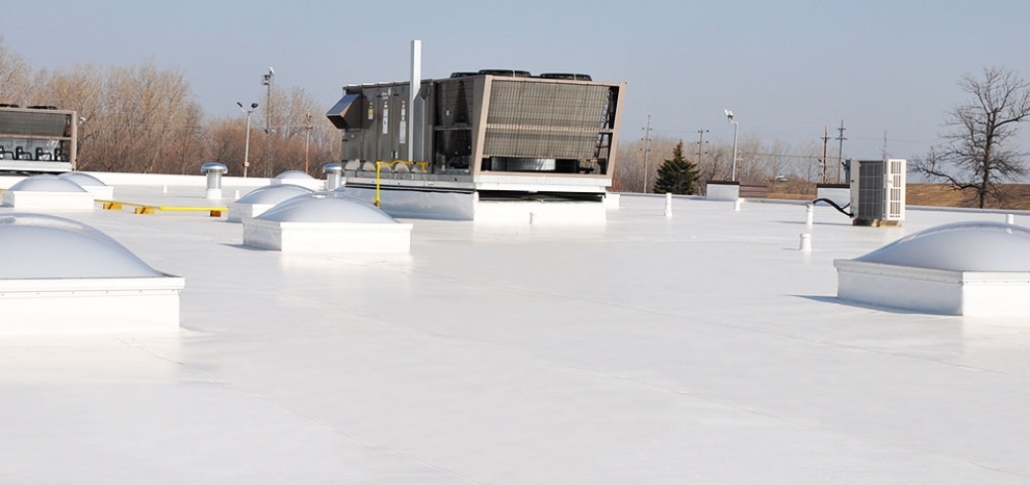
TPO (Thermoplastic Olefin) is a widely used type of commercial flat roofing material known for its durability, energy efficiency, and ease of installation. This single-ply membrane is made from a blend of polypropylene and ethylene-propylene rubber, making it a strong and flexible roofing option.
TPO is available in light colors, most commonly white, which helps to reflect sunlight and reduce cooling costs. This makes it an ideal choice for buildings in hot climates or those seeking to reduce their energy consumption.
Key Benefits of TPO Roofing
| Benefit | Description |
| Durability | TPO is resistant to UV rays, ozone, and extreme temperatures, ensuring long-term performance. |
| Low Maintenance | Requires minimal maintenance, with an easy-to-clean surface and occasional inspections. |
| Long Lifespan | TPO roofs can last up to 30 years with proper maintenance, offering good long-term value. |
| Energy Efficiency | Reflective properties of TPO reduce cooling costs, improving energy efficiency in commercial buildings. |
TPO roofing is also cost-effective and highly sustainable, often made from recyclable materials, making it a great choice for eco-conscious businesses. Its combination of durability, energy savings, and environmental benefits makes it a top contender for flat roof systems.
Request A Free Quote
Speak To Our Roofing Specialists Today!
National Roofing & Solar offers expert commercial roof replacements, leak repairs, and solar upgrades, maximizing energy efficiency and ROI.
3. PVC Roofing
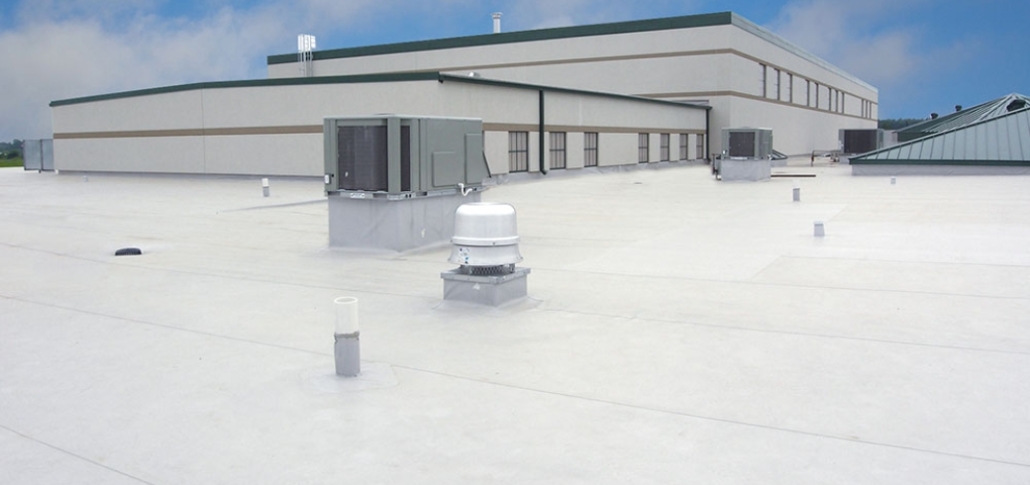
PVC (Polyvinyl Chloride) roofing is a durable and highly versatile type of commercial flat roofing material. Known for its strong resistance to chemicals, moisture, and UV rays, PVC roofing is commonly used in commercial and industrial settings, offering both performance and long-term value.
PVC roofing membranes are available in a variety of colors, with white being the most popular choice due to its reflective properties, which help to lower cooling costs by reflecting sunlight.
Key Benefits of PVC Roofing
| Benefit | Description |
| Durability | PVC is resistant to chemicals, grease, and oils, making it ideal for restaurants and industrial environments. |
| Low Maintenance | The roofing material is easy to clean and maintain, with minimal required upkeep. |
| Long Lifespan | PVC roofing can last up to 30 years or more with proper maintenance, providing a reliable long-term roofing solution. |
| Energy Efficiency | White PVC roofing reflects sunlight, reducing cooling costs and improving energy efficiency in commercial buildings. |
PVC roofing is also fire-resistant, offering an added layer of safety for commercial properties, particularly those in industrial or high-risk areas.
With its durability, energy efficiency, and safety features, PVC roofing is an ideal choice for commercial buildings seeking a long-lasting, low-maintenance roofing system.
Ready to Upgrade Your Roof with PVC? Contact National Roofing & Solar today for a free consultation.
4. Duro-Last® Roofing Systems

Duro-Last® Roofing Systems are known for their durability, precision, and long lifespan, making them a leading choice for types of commercial flat roofing materials. Made from a single-ply thermoplastic membrane, Duro-Last® is custom-fabricated to fit each roof, which ensures a high-quality, watertight seal and a perfect fit.
Duro-Last® is designed to be low-maintenance, energy-efficient, and highly resistant to extreme weather conditions, making it suitable for a wide range of commercial buildings.
Key Benefits of Duro-Last® Roofing Systems
| Benefit | Description |
| Durability | Duro-Last® is resistant to harsh weather conditions, UV rays, and chemicals, ensuring long-term reliability. |
| Low Maintenance | Its factory fabrication minimizes seams, reducing the need for repairs and regular maintenance. |
| Long Lifespan | Duro-Last® systems typically last 35-50 years, offering excellent return on investment. |
| Energy Efficiency | The reflective surface of Duro-Last® roofing helps to reduce cooling costs and improve energy efficiency. |
Duro-Last® roofing is also customizable, offering tailored solutions for each building’s unique shape and requirements, which ensures a perfect, seamless fit.
With its custom fabrication, long lifespan, and energy-saving properties, Duro-Last® roofing is an ideal choice for commercial flat roofs that require both performance and long-term value.
5. Single Ply Roofing

Single Ply Roofing refers to roofing systems that use a single layer of synthetic membrane, commonly made from materials like TPO, PVC, or EPDM. This type of commercial flat roofing material is known for its simplicity, durability, and cost-effectiveness, making it a popular choice for commercial buildings.
Single ply membranes are lightweight, easy to install, and offer excellent resistance to weathering, UV rays, and chemicals, making them ideal for flat roof applications.
Request A Free Quote
Speak To Our Roofing Specialists Today!
National Roofing & Solar offers expert commercial roof replacements, leak repairs, and solar upgrades, maximizing energy efficiency and ROI.
Key Benefits of Single Ply Roofing
| Benefit | Description |
| Durability | Single ply membranes are resistant to UV rays, chemicals, and extreme temperatures, ensuring long-term performance. |
| Low Maintenance | Requires minimal maintenance due to its smooth, easy-to-clean surface. |
| Long Lifespan | With proper care, single ply roofing can last up to 30 years or more, providing long-term value. |
| Energy Efficiency | The reflective properties of some single ply systems, like TPO, reduce cooling costs by reflecting sunlight. |
Single ply roofing is also lightweight, which makes it easier and quicker to install compared to traditional roofing systems.
With its durability, low maintenance, and energy efficiency, single ply roofing remains a top choice for types of commercial flat roofs seeking long-term reliability.
6. Liquid Coating Roofing

Liquid Coating Roofing is a versatile type of commercial flat roofing material that involves applying a liquid membrane over an existing roof surface. These coatings are typically made from materials like acrylic, silicone, or polyurethane, providing a seamless and waterproof layer that enhances the roof’s durability and lifespan.
Liquid coatings are applied directly to the roof, filling in cracks and seams, which helps to create a smooth, continuous surface. This system is ideal for extending the life of older roofs without the need for a complete replacement.
Key Benefits of Liquid Coating Roofing
| Benefit | Description |
| Durability | Liquid coatings provide a seamless, durable surface that resists UV rays, moisture, and extreme temperatures. |
| Low Maintenance | Once applied, liquid coatings require minimal maintenance, with inspections and occasional touch-ups as needed. |
| Long Lifespan | Liquid coatings can extend the life of existing roofs by 10-20 years, offering significant value. |
| Energy Efficiency | Reflective coatings help to reduce cooling costs by reflecting sunlight, improving energy efficiency. |
Liquid Coating Roofing is also cost-effective, as it eliminates the need for a full roof replacement and can be applied to a variety of existing roofing materials.
With its ability to rejuvenate old roofs, offer cost savings, and improve energy efficiency, liquid coating roofing is an excellent option for extending the life of commercial flat roofs.
7. Low Slope Roofing Systems
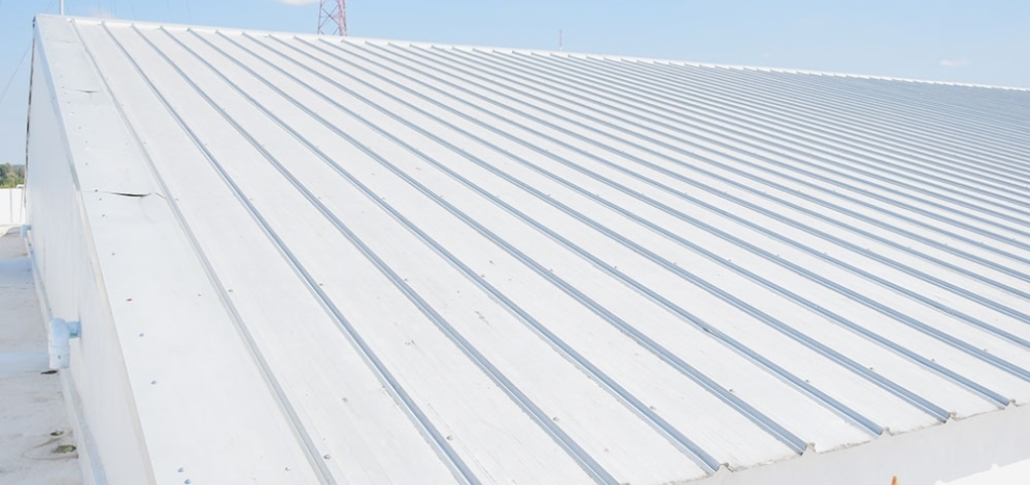
Low Slope Roofing Systems are designed for roofs with a pitch of 2:12 or less, making them a common choice for commercial flat roofing materials. These systems are designed to manage water drainage while offering cost-effective and durable roofing solutions for flat roof structures.
Low slope roofs are typically built with materials such as TPO, EPDM, PVC, or modified bitumen, providing excellent weather resistance and long-term performance.
Key Benefits of Low Slope Roofing Systems
| Benefit | Description |
| Durability | Low slope systems are highly durable, able to withstand UV rays, extreme weather, and temperature fluctuations. |
| Low Maintenance | These roofs require less maintenance compared to traditional pitched roofs, making them easier to manage. |
| Long Lifespan | With proper maintenance, low slope roofs can last up to 30 years or more, providing a reliable roofing solution. |
| Energy Efficiency | Reflective coatings or membranes can reduce cooling costs, improving the energy efficiency of the building. |
Low slope roofing is also cost-effective, as the installation process is often quicker and more affordable than traditional pitched roofs.
With their durability, ease of maintenance, and cost-effectiveness, low slope roofing systems are an ideal solution for commercial flat roofs.
8. Built-Up Roofing (BUR)
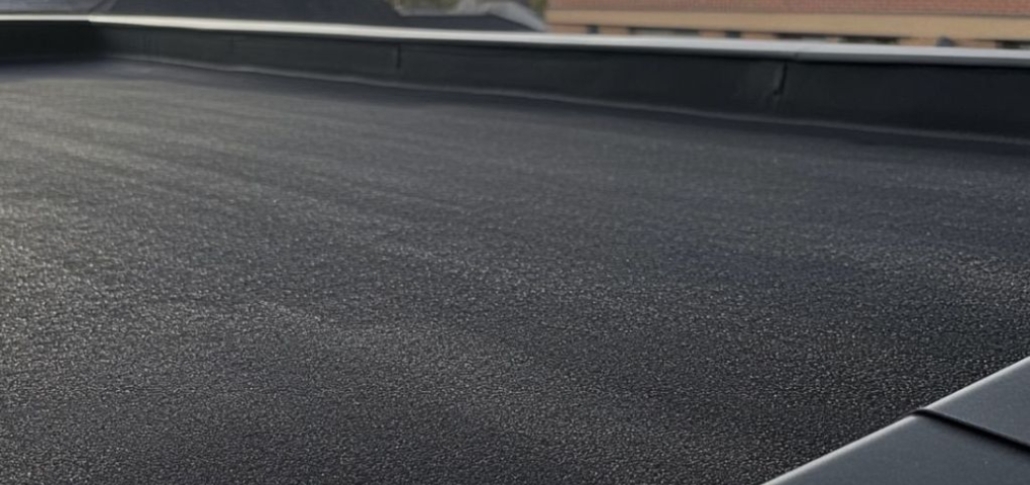
Built-Up Roofing (BUR) is one of the oldest and most reliable types of commercial flat roofing materials. This system involves multiple layers of bitumen (asphalt or tar) and reinforcing fabrics, creating a durable, weather-resistant membrane. BUR roofs are typically topped with a layer of gravel or mineral granules for additional protection.
BUR is known for its long history of performance, offering excellent waterproofing and durability.
Request A Free Quote
Speak To Our Roofing Specialists Today!
National Roofing & Solar offers expert commercial roof replacements, leak repairs, and solar upgrades, maximizing energy efficiency and ROI.
Key Benefits of Built-Up Roofing (BUR)
| Benefit | Description |
| Durability | BUR systems are known for their strength, resisting impacts, UV rays, and extreme weather conditions. |
| Low Maintenance | BUR requires minimal maintenance, with periodic inspections to ensure the integrity of the layers. |
| Long Lifespan | Built-Up Roofing can last up to 40 years or more, providing excellent long-term value. |
| Energy Efficiency | The layers of BUR can provide thermal insulation, reducing heating and cooling costs and improving energy efficiency. |
BUR is also fire-resistant, adding an extra layer of safety for commercial properties, particularly in industrial areas.
With its proven durability, low maintenance, and long lifespan, Built-Up Roofing remains a strong choice for commercial flat roofs.
Ready to Install or Upgrade Your BUR Roof? Contact National Roofing & Solar today for a free consultation. Our team of experts is ready to guide you in selecting the best Built-Up Roofing solution for your commercial property.
9. Modified Bitumen
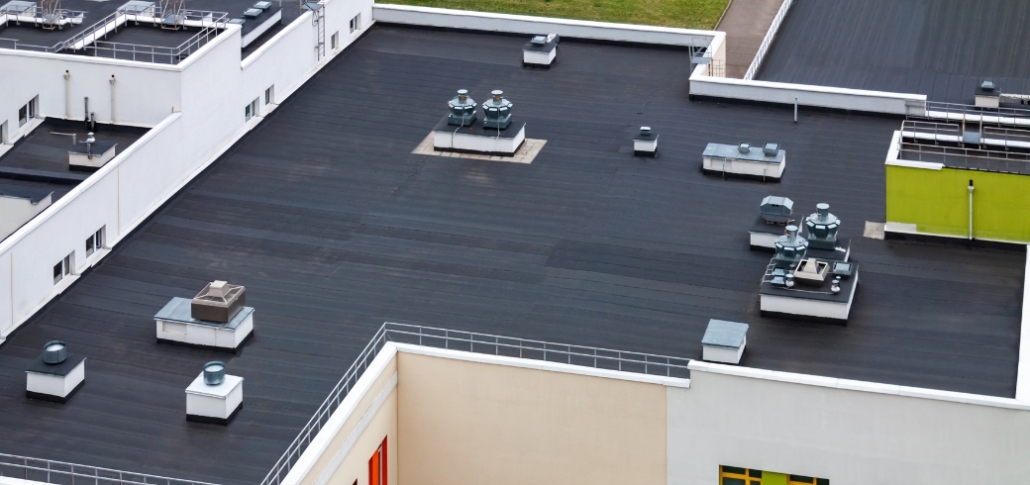
Modified Bitumen is a popular type of commercial flat roofing material made by modifying traditional asphalt with synthetic materials like rubber or plastic. This modification enhances its durability, flexibility, and performance, making it ideal for a wide range of commercial applications.
Modified bitumen is typically installed using either heat-welding, cold adhesive, or self-adhering methods, providing a strong, weather-resistant barrier for flat roofs.
Key Benefits of Modified Bitumen
| Benefit | Description |
| Durability | Modified Bitumen is resistant to weather, UV rays, and physical damage, ensuring long-term performance. |
| Low Maintenance | Requires little maintenance, with occasional inspections and simple repairs when necessary. |
| Long Lifespan | With proper care, Modified Bitumen can last up to 30 years, offering significant long-term value. |
| Energy Efficiency | Some versions offer reflective coatings, reducing heat absorption and lowering cooling costs. |
Modified Bitumen is also versatile, available in both rolled and laminated versions, giving it flexibility for different commercial roofing needs.
With its durability, low maintenance, and energy efficiency, Modified Bitumen remains a reliable choice for commercial flat roofing systems.
10. Spray Polyurethane Foam (SPF)
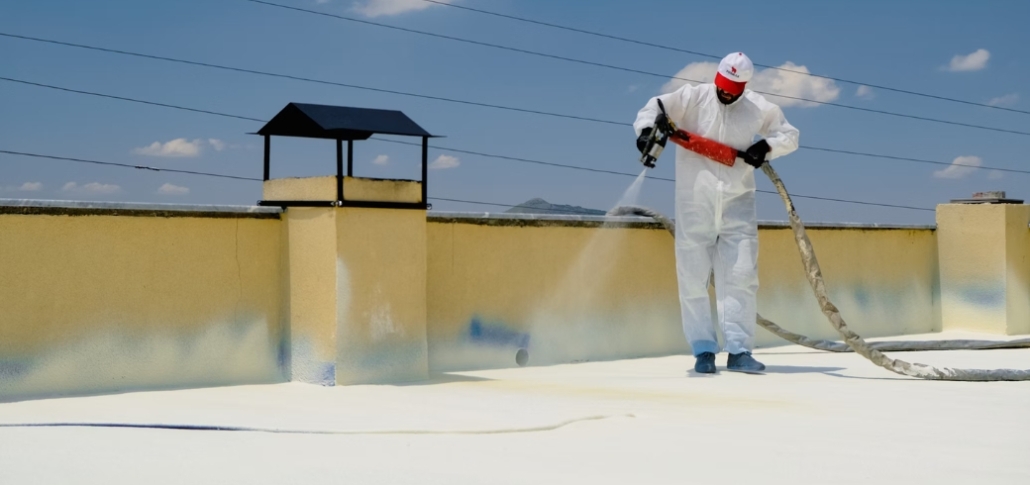
Spray Polyurethane Foam (SPF) is a unique type of commercial flat roofing material that involves spraying a liquid foam onto the roof, which then expands and hardens into a solid, seamless membrane. SPF roofing provides excellent insulation, waterproofing, and durability, making it an ideal option for both new construction and roof repairs.
SPF systems can be applied over existing roofs, making them an efficient, cost-effective solution for extending the lifespan of commercial flat roofs.
Key Benefits of Spray Polyurethane Foam (SPF)
| Benefit | Description |
| Durability | SPF is highly resistant to UV rays, weather, and physical damage, providing long-lasting protection. |
| Low Maintenance | The seamless surface requires minimal maintenance, with occasional inspections and simple repairs. |
| Long Lifespan | SPF roofs can last 20-30 years with proper maintenance, offering significant value over time. |
| Energy Efficiency | SPF provides excellent thermal insulation, reducing heating and cooling costs and improving overall energy efficiency. |
SPF is also lightweight, which reduces the load on the building structure and allows for quicker installation.
With its seamless application, energy-saving benefits, and ability to extend roof life, Spray Polyurethane Foam is an excellent choice for types of commercial flat roofs.
11. Liquid-Applied Roofing
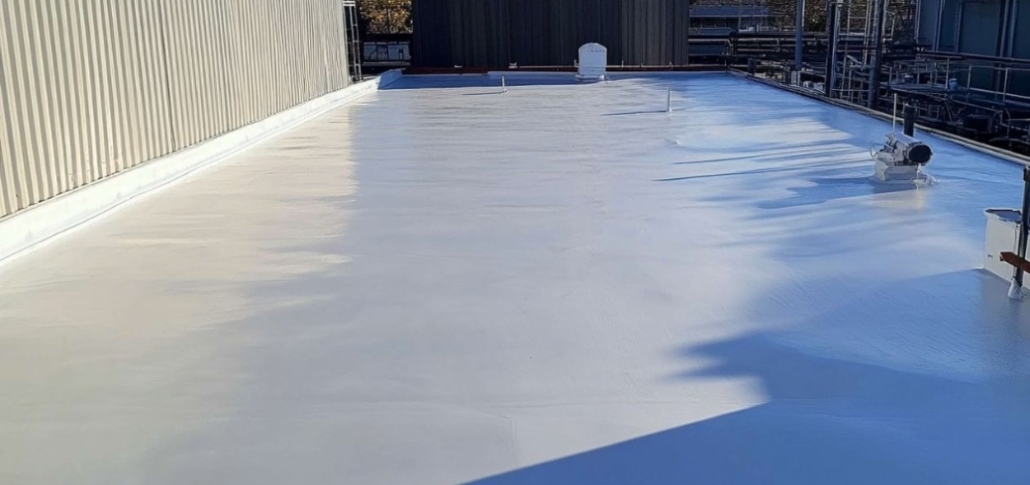
Liquid-Applied Roofing is a versatile type of commercial flat roofing material that involves applying a liquid membrane directly onto the roof surface. This system creates a seamless, waterproof layer that bonds to the roof, filling in cracks and seams for enhanced durability. Liquid-applied roofing is often made from materials like acrylic, silicone, or polyurethane.
Ideal for both new roofs and roof repairs, this system offers a cost-effective solution to extend the life of an existing roof.
Key Benefits of Liquid-Applied Roofing
| Benefit | Description |
| Durability | The seamless membrane provides strong protection against UV rays, moisture, and extreme temperatures. |
| Low Maintenance | Liquid-applied roofing requires minimal maintenance with only occasional inspections and touch-ups. |
| Long Lifespan | This system can last 10-20 years, depending on the material and maintenance, offering long-term protection. |
| Energy Efficiency | Reflective coatings help reduce cooling costs by reflecting sunlight, making it an energy-efficient option. |
Liquid-applied roofing is also flexible, allowing it to conform to irregular shapes and complex roof features, making it suitable for a wide range of building types.
With its easy application, cost-effectiveness, and energy-saving benefits, liquid-applied roofing is a great choice for commercial flat roofs seeking both durability and sustainability.
Request A Free Quote
Speak To Our Roofing Specialists Today!
National Roofing & Solar offers expert commercial roof replacements, leak repairs, and solar upgrades, maximizing energy efficiency and ROI.
12. Acrylic Roofs
Acrylic Roofs are a popular type of commercial flat roofing material known for their durability, flexibility, and excellent reflective properties. Made from acrylic-based coatings, these roofs provide a seamless membrane that is resistant to UV rays, dirt, and moisture, making them ideal for commercial buildings looking for a low-maintenance solution.
Acrylic roofs are often applied as a top coat over existing roofing systems, providing an additional layer of protection and extending the life of the roof.
Key Benefits of Acrylic Roofs
| Benefit | Description |
| Durability | Acrylic roofs resist UV rays, dirt, and moisture, providing long-term protection against weathering. |
| Low Maintenance | Acrylic coatings require little maintenance, with occasional cleaning and inspections. |
| Long Lifespan | Acrylic roofs can last up to 20 years, offering excellent durability and performance. |
| Energy Efficiency | The reflective nature of acrylic roofs helps reduce cooling costs by reflecting sunlight, improving energy efficiency. |
Acrylic roofs are also cost-effective, providing a budget-friendly option for businesses looking to extend the life of their roofs without major renovations.
With their durability, low maintenance, and energy-saving benefits, acrylic roofs are a great choice for commercial flat roof systems.
13. Metal Roofing

Metal Roofing is a highly durable and long-lasting type of commercial flat roofing material. Made from materials like steel, aluminum, or copper, metal roofs are known for their resistance to extreme weather conditions, UV rays, and physical damage. Metal roofing systems are often used for both low-slope and flat roof applications in commercial buildings.
Metal roofs are available in various styles and finishes, offering versatility and aesthetic appeal alongside their functional benefits.
Key Benefits of Metal Roofing
| Benefit | Description |
| Durability | Metal roofing is highly resistant to impacts, wind, and weathering, providing long-term protection. |
| Low Maintenance | Requires minimal maintenance, with occasional inspections to ensure no damage from storms or debris. |
| Long Lifespan | Metal roofs can last up to 50 years or more, offering superior longevity compared to other roofing materials. |
| Energy Efficiency | Metal roofing reflects solar heat, reducing cooling costs and improving energy efficiency, especially in warmer climates. |
Metal roofs are also fire-resistant, adding an extra layer of protection for commercial buildings, particularly in high-risk areas. With their unmatched durability, long lifespan, and energy-saving capabilities, metal roofing is an ideal choice for types of commercial flat roofs.
Ready to Upgrade Your Roof with Metal? Contact National Roofing & Solar today for a free consultation. Our experts are here to help you find the perfect metal roofing solution for your commercial property.
14. Concrete Roofing

Concrete Roofing is a highly durable and long-lasting type of commercial flat roofing material. Made from poured or precast concrete, this roofing system offers exceptional strength and protection against extreme weather conditions, fire, and physical damage.
Concrete roofs are particularly effective in areas with extreme temperatures, providing excellent thermal mass and energy efficiency. They are often used for flat or low-slope roofs in commercial buildings.
Key Benefits of Concrete Roofing
| Benefit | Description |
| Durability | Concrete roofs are extremely strong, resistant to weather, UV rays, and impacts. |
| Low Maintenance | Requires minimal maintenance and can last for decades with proper care. |
| Long Lifespan | Concrete roofing can last 50 years or more, providing long-term protection and value. |
| Energy Efficiency | Concrete’s thermal mass helps regulate temperatures, reducing heating and cooling costs, improving energy efficiency. |
Concrete roofs are also fire-resistant, adding an extra layer of safety for commercial properties.
With their exceptional durability, long lifespan, and energy-saving benefits, concrete roofing is an ideal option for commercial flat roofs.
Request A Free Quote
Speak To Our Roofing Specialists Today!
National Roofing & Solar offers expert commercial roof replacements, leak repairs, and solar upgrades, maximizing energy efficiency and ROI.
Key Components of Flat Roofing Systems
Flat roofing systems are composed of several key components that work together to provide a durable, weather-resistant, and energy-efficient solution. These components ensure that the roof is both functional and reliable over time. The most important components include:
Waterproofing Membranes
Waterproofing membranes are crucial for protecting the roof structure from water infiltration. These membranes create a continuous, seamless layer that prevents leaks and moisture damage. Common materials used for waterproofing membranes include EPDM, TPO, PVC, and modified bitumen.
Insulation & Reinforcement Layers
Insulation layers are essential for improving the thermal performance of the roof, helping to regulate the building’s temperature and reduce energy consumption. Reinforcement layers, such as fiberglass or polyester, provide added strength and stability to the roofing system, ensuring it can withstand external stresses and weather conditions.
Surface Coatings & Reflective Finishes
Surface coatings and reflective finishes are applied to the roofing material to enhance its performance. These coatings can protect against UV rays, extend the roof’s lifespan, and improve its energy efficiency. Reflective finishes, such as white coatings, help reduce cooling costs by reflecting sunlight and lowering the temperature of the roof.
Read More: What is the Best Commercial Roofing Material? The Full Guide

Performance & Comparison of Roofing Systems
When choosing a roofing system for types of commercial flat roofs, it’s important to consider various factors that affect its performance, including lifespan, warranty, cost, climate suitability, and maintenance. Below is a comparison of these key performance factors across different roofing systems:
Lifespan & Warranty Expectations
The lifespan of a roofing system is one of the most important factors in determining its long-term value. Systems like metal roofing and concrete roofing can last up to 50 years or more, offering the best longevity. Other systems, like TPO and EPDM, typically last 20-30 years with proper care. Be sure to check warranty details, as most manufacturers offer warranties ranging from 10 to 30 years, with coverage for manufacturing defects and performance.
Cost vs. Long-Term Value
While the upfront cost of roofing systems like modified bitumen and TPO can be more affordable, systems like Duro-Last® and metal roofing may require higher initial investment but offer longer lifespans and lower maintenance costs. Consider the total cost of ownership over the roof’s lifespan, factoring in both installation and maintenance.
Climate Suitability
Certain roofing systems are better suited for specific climates. For instance, white PVC and TPO roofing are ideal for hot climates due to their reflective properties, while EPDM is highly durable in colder climates. Concrete roofing provides excellent thermal mass, helping regulate temperatures in both hot and cold environments.
Maintenance Needs & Repairability
Maintenance requirements vary across roofing systems. Liquid-applied coatings and single-ply roofing systems generally require less frequent repairs, while BUR and modified bitumen systems may need periodic inspection and repairs due to the wear on seams. Consider how often you will need to inspect the roof and perform repairs when selecting the right roofing system for your types of commercial flat roofs.
FAQs
The best flat roof for a commercial building depends on factors such as climate, budget, and building requirements. Popular options include TPO, EPDM, and Duro-Last®, known for their durability, energy efficiency, and cost-effectiveness.
A commercial flat roof is often referred to as a low-slope roof or flat roofing system. It is designed with minimal slope to allow for water drainage and is typically covered with materials like EPDM, TPO, or PVC.
Most commercial buildings use single-ply membrane roofs like TPO or EPDM due to their cost-effectiveness, ease of installation, and durability. Built-Up Roofing (BUR) and Modified Bitumen are also commonly used in commercial properties.
Metal roofing and concrete roofing are the longest-lasting commercial flat roof systems, with lifespans of 40-50 years or more. These systems offer excellent durability and long-term value.
TPO (Thermoplastic Olefin) is a newer roofing material known for its reflective properties and energy efficiency, while EPDM (Ethylene Propylene Diene Monomer) is a more traditional, rubber-based material that offers superior weather resistance. TPO is typically used in warmer climates, while EPDM is ideal for colder regions.
Do you have more questions? Feel free to contact us for more information or to get personalized advice.
Request A Free Quote
Speak To Our Roofing Specialists Today!
National Roofing & Solar offers expert commercial roof replacements, leak repairs, and solar upgrades, maximizing energy efficiency and ROI.
Conclusion
In this article, we explored a variety of commercial flat roofing systems, including EPDM, TPO, PVC, Duro-Last®, and more. Each roofing system offers unique benefits, such as durability, energy efficiency, low maintenance, and long lifespan, making it important to choose the right option based on your building’s needs, climate, and budget.
Whether you’re looking for a cost-effective solution, a system that provides long-term value, or one that is energy-efficient, there is a flat roofing system to meet your needs.
Ready to choose the best commercial flat roofers?
Contact National Roofing today to get expert advice and a free consultation tailored to your specific needs.


